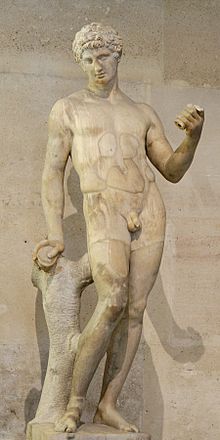| Adonis | |
|---|---|
Mortal lover of Aphrodite & Persephone | |
 Adonis Mazarin, completed from an ancient torso by François Duquesnoy, formerly in the collection of Cardinal Mazarin, currently held in the Louvre Museum | |
| Symbol | anemones, as well as lettuce, fennel, and other fast-growing plants |
| Personal information | |
| Parents | Cinyras and Myrrha (by Ovid), Phoenix and Alphesiboea (by Hesiod) |
| Consort | Aphrodite and Persephone |
| Children | Golgos, Beroe |
| Equivalents | |
| Mesopotamian equivalent | Dumuzid, Tammuz |
| Levantine/Canaanite equivalent | Tammuz, Adonai |
In Greek mythology, Adonis[a] was a mortal lover of the goddess Aphrodite and of Persephone.
One day, Adonis was gored by a wild boar during a hunting trip and died in Aphrodite's arms as she wept. His blood mingled with her tears and became the anemone flower. Aphrodite declared the Adonia festival commemorating his tragic death, which was celebrated by women every year in midsummer. During this festival, Greek women would plant "gardens of Adonis", small pots containing fast-growing plants, which they would set on top of their houses in the hot sun. The plants would sprout, but soon wither and die. Then the women would mourn the death of Adonis, tearing their clothes and beating their breasts in a public display of grief.
The Greeks considered Adonis's cult to be of Near Eastern origin. Adonis's name comes from a Canaanite word meaning "lord" and most modern scholars consider the story of Aphrodite and Adonis to be derived from the earlier Mesopotamian myth of Inanna (Ishtar) and Dumuzid (Tammuz).
In late 19th and early 20th century scholarship of religion, Adonis was widely seen as a prime example of the archetypal dying-and-rising god. His name is often applied in modern times to handsome youths, of whom he is the archetype.
https://en.wikipedia.org/wiki/Adonis

No comments:
Post a Comment